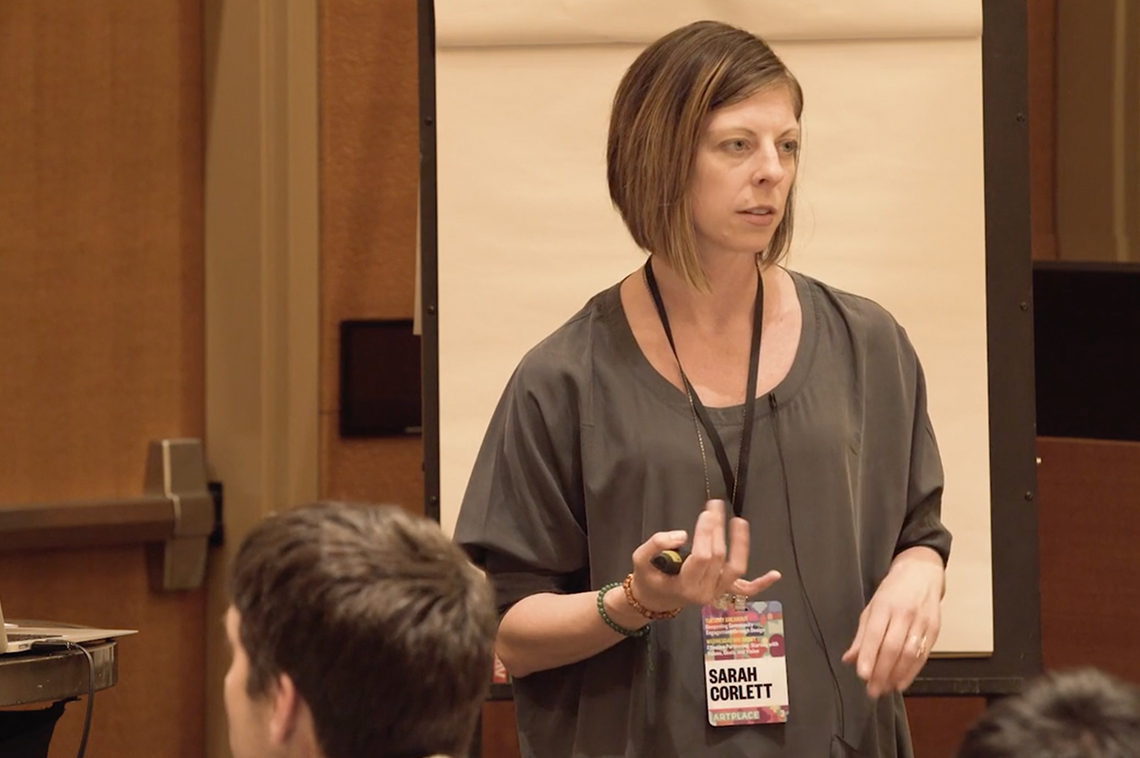
Albert Einstein once said, “If I had an hour to solve a problem, I’d spend 55 minutes thinking about it and 5 minutes solving it.” Those of us working in the creative placemaking field are familiar with this philosophy–the idea that the challenge of understanding a problem should take precedence over the action of executing a solution. But where–and how–do we begin?
When a problem feels too big or too out of reach, what tools do we have at our disposal to help us break things down and examine the problem from all possible angles? Design thinking might be the answer.
At this year’s ArtPlace Summit, attendees had the opportunity to learn from experts and ArtPlace grantees during a series of breakout sessions. On Tuesday, May 16, two groups of summit attendees received a crash course in design thinking thanks to a breakout titled “Deepening Community Engagement Through Design” led by Sarah Corlett, director of community development and strategy for Design Impact in Cincinnati, OH.
“Design thinking is a powerful tool,” Sarah told us in her introduction to the session. “In its simplest form, it’s a problem-solving process. It calls on three things: creativity, empathy and rationality.”
Design thinking works by asking people to prolong the problem-solving experience. Sarah suggests starting by cultivating relationships with people in the community, building empathy with them through techniques like empathic interviewing (conversations that employ active listening techniques like body language awareness), and brainstorming ideas together before testing anything out.
The practice of design thinking suggests that we can use empathy and human connection as a means of recognizing multiple perspectives and as a way to break down assumptions. When we use empathy as a technique for deeper community engagement, we can reframe a problem as an opportunity.
But most importantly, design thinking offers practitioners a way to make sure they’re actually trying to solve the right problem.
“There’s an unfortunate history, in both the creative placemaking and design fields, of well-intentioned artists or designers entering a community and diagnosing what they think the problem is,” Jamie Hand, ArtPlace America’s director of research strategies, reflected after the session. “They’ll come up with a solution to a problem only to realize that it has nothing to do with that community’s reality. But that’s not the kind of approach we are interested in, and anybody can learn to use the tools design thinking offers. It’s a human, universal way of working in communities.”
During the breakout session, Sarah outlined her approach and explained the specific steps she and her team use. At the forefront of the design thinking method is a willingness to spend a lot of time framing and reframing a problem.
“Design thinking asks you to look at your problem from a lot of angles so that when you start having conversations with people in the community, you really understand the problem and you can see it from multiple perspectives. We want to make sure we’ve got the perspective right before we dive in,” Sarah explained. By ensuring that organizers and developers listen carefully to residents and actively work to seek out differing perspectives, design thinking can help prevent a lot of headaches and complications down the road.
For example, the Design Impact team spent some time working in a Head Start community in Kentucky to try to help increase enrollment in a preschool program. The neighborhood was geographically isolated, making transportation in and out difficult. To reframe this challenge as an opportunity, the Design Impact team started by asking a question: “How might we increase access to transportation so that we can bump up our Head Start number?”
To make sure that their assumption was backed up by the community, the team started asking residents for their perspectives. But they quickly found out that they were approaching the problem from the wrong direction.
Parents told Sarah and her colleagues that they believed their kids would be bored in preschool–that’s why they weren’t enrolling them. Transportation wasn’t an issue at all. With this new information, the Design Impact team reframed the problem and instead asked “How might we shift parents’ attitudes about preschool?” A few public demonstrations of the preschool program were all it took to triple enrollment in two weeks.
If the Design Impact team hadn’t slowed the problem-solving process down by questioning their own assumptions while empathizing with and listening to the community, $75,000 worth of funding would have gone toward a solution that wasn’t a solution at all.
“Design thinking helps to uncover the motivations, meaning and values behind actions,” Sarah told the breakout attendees. “It’s a lot of asking ‘why’ and also being silent. You have to give people time and moments to share their thoughts.”
While it can be difficult to carve out that time from stressful project schedules, the results that come from employing design thinking techniques are proof that slowing things down can be the key to shaking things up. One of the breakout attendees, Sophie Constantinou, co-founder of Citizen Film in San Francisco, CA, summed things up: “Yes, empathy is time-consuming, but time commitments build relationships. We can’t minimize how important that is.”
You can view the materials used during the breakout here and here. You can also view the FULL video of the session below as well!
-
Kayla Goggin is a freelance writer working for ArtPlace America. She can be reached at gogginkayla [at] yahoo.com.
-





